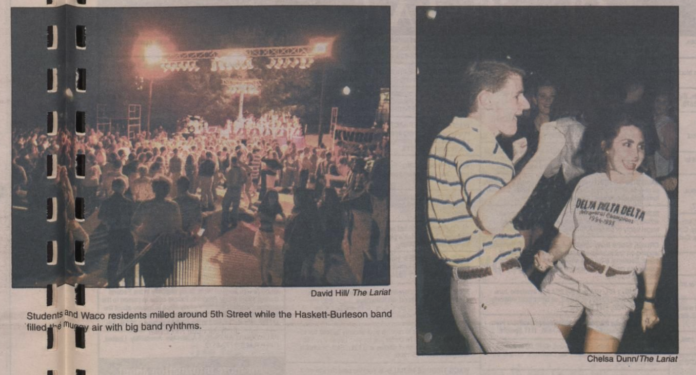
By Lucy Ruscitto | Staff Writer
In February of 1996, Baylor President Robert Sloan Jr. — after lifting the 151-year-long on-campus dancing ban — celebrated the rule reversal with his wife, Sue Sloan, by dancing to a Beethoven minuet in front of the student center.
Breaking from the strict Baptist ways of the university and catching national attention in the process, Baylor’s reversal of the rule seemed to pave the path for greater university inclusivity.
Because of Baylor’s strict relationship with the Southern Baptist Convention, dancing, like drinking and tobacco use, was viewed as sinful.
In a Baylor Lariat article from 2011, Baylor University Chaplain Dr. Burt Burleson said “all the things around drinking came to be thought of as sinful. For instance, if you went to the honky-tonk to drink, that’s where you also went to dance, so dancing became problematic.”
According to The New York Times, Sloan “warned students against being ‘obscene or provocative.’ No pelvic gyrations; no excessive closeness; no ‘Dirty Dancing.'”
Dr. Baudelio Garza is an associate professor of Spanish who traveled to Baylor to be a “visiting lecturer” in 1988 but has taught at the university ever since. When he arrived on campus, Garza said he noted the cultural distinctions compared to other places he had been an instructor.
“The campus culture, compared to other institutions I have taught in Mexico, was very conservative towards Christian [and] Baptist religious values and the behavior of students and teachers in campus and outside campus,” Garza said.
Wendy Browder Kula graduated from the university in December of 1989, prior to the reversal of the ban. Although she grew up in a Methodist home, Kula said Baylor had always been the place for her as her mother also attended the university in the 1960s, when rules were even stricter.
She said now she laughs at the then-stern ways of the university.
Kula said while living on campus, the girls dormitories were never allowed to have boys in their rooms — except for twice a month on Sundays — with the doors swung wide open. Additionally, Kula said compared to today’s modern college-student dress, she and her classmates were much more traditional.
“There was also a curfew, and the door was locked, and the lady at the front desk had to let you in and she’d get mad at you if you were late. It was a big deal,” Kula said.
Kula said every day, she and her classmates did not “slum it” like the college kids are so apt to today but truly looked much more “formal” and tried to do so on a daily basis.
“We got dressed up. I wore a skirt. I looked cute. I put makeup on pretty outfits, bows in our hair, the whole nine yards,” she said.
Kula said her friends at other schools had different college experiences from her own, which she believes can be attributed to the Baptist culture. When she and her friends wanted to dance, they would take a trip to downtown Waco to boogie on the Waco Suspension Bridge.
“I’m not a rule-breaker, but I could still follow the rules and be my own person,” Kula said. “We just questioned it a lot, like why?”
Kula said throughout her time at Baylor, she and her friends always heard a rumor that they believed was an attempt to discourage students from breaking the rule.
“It was rumored that a woman who had given money for some of the buildings said that if there was ever dancing her buildings would have to be burned down,” Kula said. “But I never knew if that was really true.”
Dr. Matt Gerber, associate professor in the communication department and the Glenn R. Capp Endowed Chair of Forensics at Baylor, said he experienced what he believes could have been one of the first on-campus dances at the university. He had not yet been employed by Baylor, but he was working as an employee at a debate camp for high schoolers for the Glenn R. Capp Debate Forum at Baylor in late July of 1996.
“My predecessor, Dr. Karla Leeper, was the director of Baylor’s debate program at the time, and she decided to host a dance at the end of the debate workshop,” Gerber said. “Her reasoning was that since the Baylor debate program was the oldest co-curricular activity at Baylor, we should continue to make history by hosting the first dance on campus.”
Gerber said he and Leeper hired a DJ with a huge sound system and held the dance in the Marrs McLean Gymnasium on campus.
“There were several hundred high school students [because] our summer debate camps were huge in the 1990s and dozens of camp staffers to act as chaperones. The students were well-behaved, and for the most part, danced appropriately,” Gerber said. “Much fun was had by all, I remember lots of music by ‘Ace of Base’ and ‘Vanilla Ice’ playing over the speakers, and it was definitely exciting to be a part of Baylor’s history.”
Kula said she is grateful that Baylor decided to rescind its original rule, believing it truly has turned the historically Baptist school into more of an “inclusive,” Christian school.
“I’m just glad that they finally did change it,” Kula said.
Garza said he also thinks the dissolving of the on-campus dancing ban was a smart move by the university for its own growth.
“In general, I think that the students in the present times are more open and willing to consider dancing as an activity that allows them to be able to better understand and enjoy the cultures of other people,” Garza said. “While keeping the Christian values as a distinctive feature of Baylor, the lifting of the rule has affected positively the culture of campus by projecting Baylor more as a modern university, open to new attitudes and ways of thinking.”





